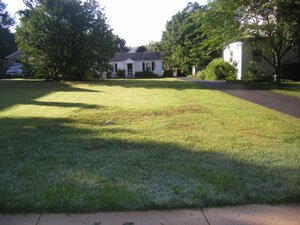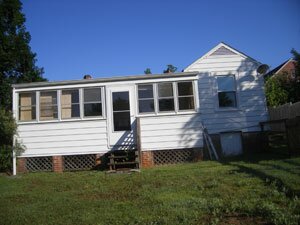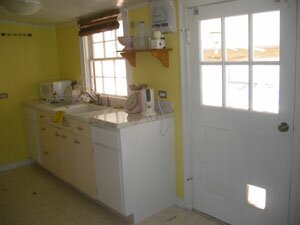REAL ESTATE- ON THE BLOCK- Locust lots: Many options for unusual parcel

PHOTO BY ROSALIND WARFIELD-BROWN
ADDRESS: 1028 Locust Avenue
NEIGHBORHOOD: Locust Grove
ASKING: $335,000
ASSESSMENT: $258,800
YEAR BUILT: 1945
SIZE: 834 fin. sq. ft., 120 unfin.
LAND: 0.32 acres
CURB APPEAL: 6 out of 10
OWNER/AGENT: Harmony Thurston, Mountain Area Realty, 823-7799
We're big on euphemisms here at On the Block, and one that's right up there with "handyman's delight" is "the possibilities are endless."
But sometimes these tired bromides have a glimmer of truth, and while in the case of this parcel at the far end of Locust Avenue the possibilities are not exactly "endless," three are at least interesting to consider.
The property consists of a long narrowish lot with a tiny house at the rear and a large garage/storage shed incongruously plopped almost directly in front of it. The current owner's grandparents were the first to live in the house after it was built in 1945, and it's been in his family ever since.
But much has changed in Charlottesville since 1945. The relatively few desirable building lots in town are at a premium, and development plans often seem to spark controversy among neighbors who have become used to the open space. Consider the dust-up that recently erupted on Second Street when plans for a two-story, 6,000-square-footer on a graceful terraced lot that's been vacant for years were approved by the Board of Architectural Review.
According to this Locust Avenue owner, since a new house was built on a similar narrow lot just two doors up, neighbors are eyeing the "for sale" sign at the top of the parcel with anxiety. But perhaps their fears are premature.
The options for the lot are threefold. An unimaginative buyer who doesn't want to make waves (and wants to be popular with the neighbors) can pony up the $300,000+, move in, and live happily ever after.
The two-bedroom, one-bath aluminum-sided house, while small, with some cosmetic upgrades could be comfortable for a single person or couple without much baggage (or pretensions, or desire for luxury). The bedrooms are of average size (one is paneled, but it's been pained white), the full (if tiny) bath has been redone with tile floor and new sink, and there's a surprising amount of storage space.
While the kitchen is the place that could use the most attention– it's outdated, with metal cabinets, stained porcelain sink, and linoleum floor– it adjoins a glassed-in porch that could probably be incorporated to make a large kitchen/family room without extraordinary expense.
The house has electric baseboard heat, oak floors, ceiling fans (and window units) in some of the rooms to compensate for no central air, a long asphalt driveway (shared with a neighbor), and a fenced backyard.
But if the little house is just too plebeian (or too small), slightly more ambitious– and more well-heeled– new owners can tear it down– big garage and all– and build a stately house to their liking. The set-back from Locust Avenue is 60 feet, but from Martin Street behind the lot, it's only 25 feet. So a new showplace could be situated almost anywhere on the lot, leaving lots of space for gardens front and back.
(One slight variant here that would not require subdividing would be to keep the little house and join it to a new one in front with a breezeway. This scenario is too complicated for us to grasp, so we hurry on to the last option.)
The most ambitious plan– and probably the wisest use of the parcel from an investor's point of view– would be to subdivide the property and build two houses, one facing Martin Street and one Locust. This obviously involves the greatest capital investment, but also probably the greatest return– if not in the current market, at least in the future.
There is, however, one large obstacle on the road to realizing this option, and it lies underground. It seems that developers in this vicinity in the '40s and '50s used something called "Orangeburg piping," a sewer formed by laminated layers of ground wood cellulose fibers infused with tar or pitch. Such pipes used no gaskets or joint sealant, making them potentially susceptible to root intrusion. According to the owner, most of what are sometimes called "coal-tar impregnated toilet paper tubes"– including the ones serving this house– have failed and had to be replaced.
The replacement option these owners chose– piping sewage uphill (the lot slopes up) to Locust instead of following the original Orangeburg route downhill to a sewer line on the far side of Martin Street– means (not to put too fine a point upon it) major headaches for new construction on this lot. Subdivision would force a return to the downhill route of the old Orangeburg pipe. (The owner, however, is willing to help pay for new plumbing if the subdivision option requires it.)
So while not "endless," it's clear the possibilities here are multiple: what happens to this lot can range from status quo to over-the-top. Ambition, budget, and imagination seem to be the most obvious elements that will determine its fate.
Oh, and considering the fall-out on Second Street, maybe an interest in being a responsive neighbor.


PHOTOS BY ROSALIND WARFIELD-BROWN
Each week, a brave local seller invites the Hook to provide an impartial, warts-and-all look at their real estate listing. E-mail yours today!
#
1 comment
March 2009, and this place now has an asking of $260K. Seller should list for $200K and take whatever he's offered; he paid $80K and it's all profit at this point.